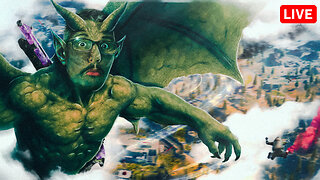Premium Only Content

How do Aeroplanes FLY
Airplanes fly using the principles of aerodynamics. There are four main forces involved in flight: lift, weight (gravity), thrust, and drag.
Lift: Lift is the upward force that counteracts the weight of the airplane. It is generated by the wings as they move through the air. The shape of the wings, known as airfoils, is specially designed to create lift. The wings are curved on the top and flatter on the bottom, which causes air to flow faster over the top, creating lower pressure compared to the bottom. This pressure difference generates lift, pulling the airplane upward.
Weight: Weight, or the force of gravity, is the downward force that the airplane must overcome to stay in the air. The weight of the airplane is counteracted by the lift generated by the wings. By adjusting the angle of the wings (angle of attack) and the speed of the aircraft, the lift can be equal to or greater than the weight, allowing the airplane to stay airborne.
Thrust: Thrust is the forward force that propels the airplane through the air. It is generated by engines, such as jet engines or propellers. The engines produce a high-speed exhaust or a powerful rotating force that pushes the airplane forward. The thrust must be greater than the drag to accelerate the aircraft and maintain flight.
Drag: Drag is the resistance encountered by the airplane as it moves through the air. It is caused by the interaction between the aircraft and the air molecules. There are two main types of drag: parasite drag and induced drag. Parasite drag includes form drag (resulting from the shape of the airplane) and skin friction drag (caused by friction between the air and the aircraft's surface). Induced drag is generated as a byproduct of lift creation. To minimize drag, airplanes are designed with streamlined shapes, smooth surfaces, and efficient wing configurations.
To initiate flight, the airplane gains speed on the runway. As the speed increases, the airflow over the wings generates lift, eventually becoming greater than the weight of the aircraft. Once sufficient lift is generated, the airplane becomes airborne. By adjusting the throttle to control engine thrust, and the control surfaces (ailerons, elevators, and rudder) to control the direction and attitude of the airplane, pilots maintain flight and control the aircraft during various maneuvers.
It's important to note that this is a simplified explanation of how airplanes fly. The actual process involves complex aerodynamic principles and control systems that ensure safe and efficient flight.
-
 4:45:15
4:45:15
RalliedLIVE
10 hours ago $1.85 earnedWarzone Domination w/ Ral
60.8K1 -
 1:10:17
1:10:17
Sarah Westall
11 hours agoWorld Leaders Increasingly Display Panic Behavior as Economic Change Accelerates w/ Andy Schectman
90.2K18 -
 59:54
59:54
Motherland Casino
8 hours ago $2.14 earnedScar x Ayanna
38.9K7 -
 41:57
41:57
BonginoReport
14 hours agoProtecting Kids From WOKE Ideology in School (Ep. 35) - Nightly Scroll with Hayley Caronia -04/25/25
126K51 -
 7:17:12
7:17:12
SpartakusLIVE
11 hours agoFriday Night HYPE w/ #1 All-American Solo NUKE Hero
32.1K -
 1:15:07
1:15:07
Kim Iversen
1 day agoThe Left Is Dead — What And Who Will Rise From the Ashes?
108K104 -
 2:06:17
2:06:17
Joker Effect
9 hours agoYOU DON'T UNDERSTAND FREEDOM OF SPEECH IF THIS MAKES YOU MAD!
17.1K1 -
 1:45:26
1:45:26
vivafrei
15 hours agoSantos Sentenced to 87 MONTHS! Corrupt Judges ARRESTED! Some Canada Stuff & MORE!
146K103 -
 4:34:03
4:34:03
Nerdrotic
15 hours ago $34.24 earnedStar Wars GRAPED? Hollywood In Freefall, Silver Surfer is a MAN! | Friday Night Tights 351
105K35 -
 1:33:35
1:33:35
Keepslidin
11 hours ago $1.03 earned$5000 START | ROAD TO 100K | Mother.land
31.1K3